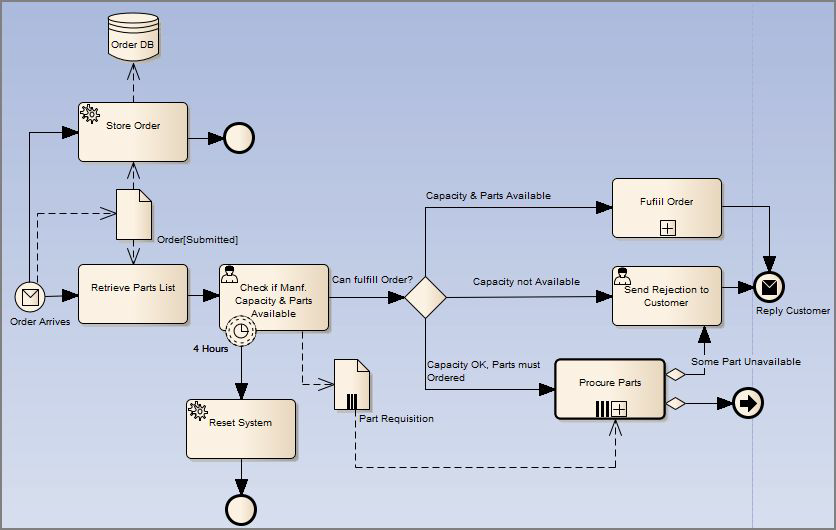| Prev | Next |
BPMN 2.0 Business Process Toolbox Pages
To create BPMN elements and relationships on Business Process diagrams in either BPMN 2.0 or BPEL formats, you can use the 'BPMN 2.0 Business Process' pages of the Diagram Toolbox.
Access
Use any of the methods outlined here to display the Diagram Toolbox, then click on  to display the 'Find Toolbox Item' dialog and specify 'BPMN 2.0 Business Process'.
to display the 'Find Toolbox Item' dialog and specify 'BPMN 2.0 Business Process'.
|
Ribbon |
Design > Diagram > Toolbox : |
|
Keyboard Shortcuts |
: |
|
Other |
Click the
|
BPMN 2.0 Business Process Elements
Item |
Use to |
|---|---|
|
Business Process |
Extend a composite Activity that defines a business process. |
|
BPEL |
Define the behavior of an executable or abstract business process. |
|
Activity |
Represent work that is performed within a Business Process. An Activity can be modeled as a:
As a sub-process, the Activity can be made a composite element that links to a child diagram containing the flow of other BPMN elements. A BPMN Activity is initially created on a diagram with the name centered at the top. If you drag elements onto the Activity the name can be obscured, so the system automatically moves the name into the top-left corner out of the way. You can also control this movement manually, by right-clicking on the element and selecting the 'Is Expanded' option to toggle the setting. |
|
Global Task |
Define a task or activity performed in the top-level process, at a higher level of execution. |
|
Data Object |
Provide or store the information for an Activity. |
|
Data Store |
Represent a mechanism for an Activity to retrieve or update stored information. |
|
Start Event |
Define the initiating event in a process. Elements of this type cannot be edge-mounted on other elements. |
|
Intermediate Event |
Define an intermediate event in a process. Elements of this type can only be edge-mounted on Activity elements. |
|
End Event |
Define the terminating event in a process. Elements of this type cannot be edge-mounted on other elements. |
|
Gateway |
Define a decision point in a business process. If a condition is true then processing continues one way; if false, then another. |
|
Pool |
Extend a Partition element to logically organize an Activity. |
|
Lane |
Extend a Partition element to subdivide a Pool. |
|
Message |
Represent the contents of a communication between two elements. |
|
Group |
Extend a Boundary element to group other elements. |
|
Text Annotation |
Create a comment. |
|
BPMN 2.0 Business Process Connectors |
Sequence Flow Use to: Extend a Control Flow relationship to define the flow of activity. |
|
Association |
Link the information and Artifacts with BPMN graphic elements. |
|
Message Flow |
Extend a Control Flow relationship to define the flow of communications in the process. |
|
Data Association |
Move data between Data Objects, Data Store, Properties and Activities, Processes. |
|
Conversation Link |
Connect a Conversation Node with a Pool, in either direction. |
BPMN 2.0 Business Process Connectors
Item |
Use to |
|---|---|
|
Sequence Flow |
Sequence Flow Use to: Extend a Control Flow relationship to define the flow of activity. |
|
Association |
Link the information and Artifacts with BPMN graphic elements. |
|
Message Flow |
Extend a Control Flow relationship to define the flow of communications in the process. |
|
Data Association |
Move data between Data Objects, Data Store, Properties and Activities, Processes. |
|
Conversation Link |
Connect a Conversation Node with a Pool, in either direction. |
Example BPMN 2.0 Business Process Diagram

Notes
Learn more
 | BPMN 2.0 | BPMN 2.0 Business Process
| BPMN 2.0 | BPMN 2.0 Business Process icon on the Diagram caption bar to display the
icon on the Diagram caption bar to display the 
